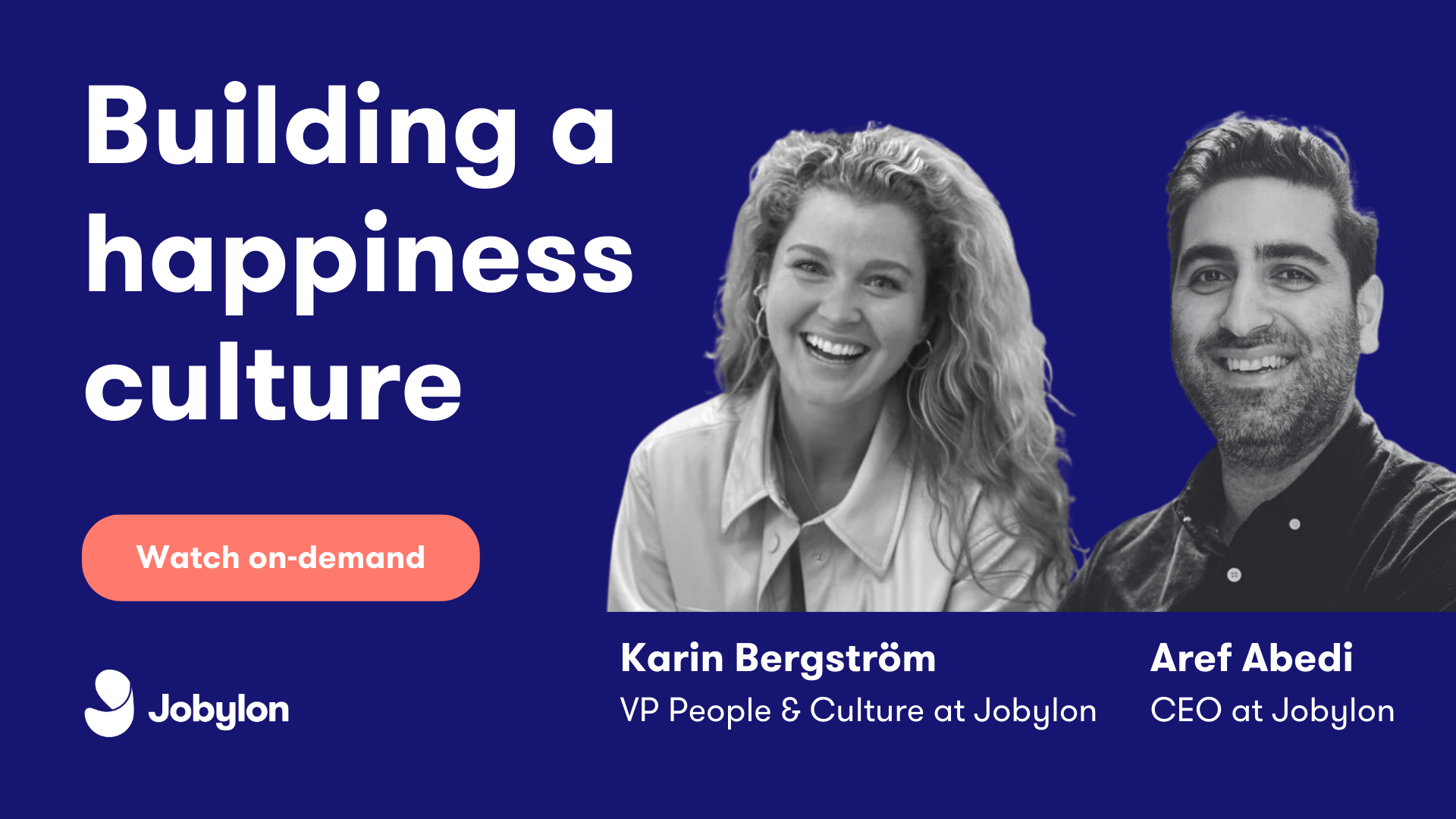Employee happiness means different things to different people, but it might not be the go-to for defining a company culture. So what makes a “happiness culture”? Is it possible to intentionally create one, and if so, how do you go about it? In this article, we’ll share the evolution of the Jobylon happiness culture, and explore practical ways to cultivate happiness in your workplace today.
A brief company history
According to Jobylon CEO Aref Abedi, in order to understand the creation of Jobylon’s happiness culture, we have to look at the journey and development that Jobylon has gone through.
In Aref’s words:
“We've always had the same kind of vision and idea to help organizations better attract talent and hire them in a better and more efficient way. It’s a very broad vision that can be fulfilled in many ways”.

The company was founded in 2011, but over the following decade, the business has been completely reformed twice. It started as a job board with a twist, with what at the time seemed like a very strong idea behind it. But after a couple of years, the team realized that while they were very good at selling, they weren’t really creating value for their customers. In one day, they went from 13 employees to just four.
After scaling back, the focus turned to product over sales. Jobylon Bounty was created, based on an idea to make everyone into a headhunter via Facebook, recommending friends to jobs and getting paid once they were hired. This created a lot of buzz in the industry, and the team was featured in many of their sought-after lists of top startups. After a while, however, they realized again that value wasn’t really being created. The team of four was now down to two.
Why is this crucial to understand in order to understand the creation of Jobylon’s happiness culture? Because of what happened during the next phase.
At this point in the journey, there was a mind shift. The team started listening to customers in a different way. Seeking to understand where they could actually create value, but also challenging customers' views. The team realized that the applicant tracking systems on the market weren’t really delivering the value they could and should, and decided to focus on building something that would. In 2016, they launched the early version of what Jobylon is today.
How the focus on happiness came about:
Culture-wise, there was another shift throughout this period. The team grew to five people, with one of the original employees coming back as well. Why? Because of the happiness and meaningfulness she felt at Jobylon, all the way from the beginning.
In Aref’s words:
“Why did she come back? Because the word happiness came back too. Happiness for us is not walking around smiling and laughing, even though that's part of it. But happiness for us is how you create a culture where everyone can feel relevant and everyone has an impact, and you're part of a bigger thing in that sense.
We learned that from a lot of failures, and I think people need to do that. I think it’s hard to kind of sit one day and workshop your values, and then it becomes perfect. It’s a process, and for us that required failing.”
According to Aref, there were really two learnings that ultimately led to shaping a culture of happiness.
- If you iterate enough times, eventually, you will succeed.
“But the question is, when do you stop? How many times do you try? We had a fantastic team, and a fantastic board that kept saying “one more time”. And I kept asking our board of investors why they still invested in us. They said, “Someone will make it, why not us?” And that kind of simplified the whole journey”. - When so many companies and start-ups fail, there has to be meaning in what you do.
“That's just the name of the game. So the realization for us was: what's the point of all of this and of working so hard as we do if we're not having fun while we're doing it? If we're not doing it with people that we actually enjoy working with, if we're not doing something valuable, what’s the point?
Turning ideas into values
With these realizations at hand and a deeper understanding of why happiness became such a clear focus for the Jobylon team, let’s take a look at the values that they eventually imposed to be able to carry this culture forward.
- Passion for People
Cultivating a humanized workplace on trust, empathy, and transparency is key and something that is permeating the entire culture at Jobylon. They believe that the key to real success lies in people feeling safe enough to be their full selves at work. - Passion for Product
Creating a seamless experience for Jobylon users starts with unlocking the creativity within. Jobylon employees should lead with a curious mind and dare to ask questions, make their voices heard, and challenge each other and the product in order to bring the latest technology to the market. - Passion for Business
Enthusiasm and grit are the driving force behind everything at Jobylon. This translates into daring to set and meet ambitious goals, walk the extra mile, and always strive for better. Employees bring out the best in each other by continually challenging one another and not settling for average.
Each of these values also comes with a clear set of foundational behaviors attached to them, to make it easier to understand and adhere to the values in employees’ daily work. They are also reiterated and developed over time, just as the company is.
Aref explains: “Along the way, our values have been our North Star. Values are just words, no one has bad ones. No one has “Be mean” as their values. Everyone has good values, but it's all about what they mean to the company, to the people. How do we live our values? So this is something we talk about often. It’s how we set our performance reviews and salaries and goals - everything goes back to the values. They have a definition for us in the company, and that definition will change with time.”
More than just values, you need meaningfulness and context
Now all of this might sound terrific, but there are a lot more things than values that need to be in place for this type of culture to thrive and encourage performance. Let’s hear what Karin Bergström, VP People & Culture, has to say about the concepts you need to focus on to build a successful happiness culture. For Jobylon, it really boils down to two concepts:
Meaningfulness:
Driving performance is all about creating meaningfulness. The Harvard University Second Generation Study (Harvard Gazette, 2017), spanning over 80 years of research, concluded that happiness seem to come down to feeling meaningfulness and forming meaningful relationships.
The focus on creating meaningful relationships goes beyond individual teams at Jobylon, rather the focus lies in shaping cross-functional relationships and trust throughout the entire organization.
As Karin herself says:
“If you have these meaningful relationships within your teams and also cross teams, you will create accountability, and each and every individual in your team will feel that their work actually matters not only for them but for the entire company.
It’s also important to note that it doesn’t have to be meaningfulness in terms of “we need to save the world from climate change”, but more meaningfulness on a micro level. How can I find a company where I actually can see the results and the work I'm doing and feel meaningful?”
A crucial aspect in shaping meaningfulness is to have managers who actudally know how to encourage and instill that feeling of meaningfulness in their employees. Research is clear (HBR, 2022) that training managers in how to handle their employees only becomes more and more important as our work becomes more and more complex, and at the end of the day, a company culture won’t survive unless managers lead the way in how to act.
As Karin sees it, there are three levels to creating meaningfulness, and it all comes down to recognition and positive feedback.
- Level 1: Saying “Good job!” to an employee after completing something. This might be positive to hear, but it won’t necessarily make the employee feel that their work has meaning.
- Level 2: Going further in their feedback and saying “Good job! I saw that you put a lot of time and effort into this”. Here the manager recognizes the employees’ hard work, but it’s still not enough to create meaningfulness. We need a bit more context put into this.
- Level 3: Here the manager moves another step up and provides context. “Good job! I saw that you put a lot of time and effort into this. But thanks to your great performance, we can call this customer an ambassador, and that allows us to be able to continue growing Jobylon outside of the Nordics.” This is the level we should aspire for all our managers to consistently be at; providing not only positive feedback but also clear reasoning for why this work is important.
Context over control
As organisations grow, there is often a focus on creating processes and playbooks. Nailing down the perfect way of doing things can feel like the best way to sort out the mess a growing organization often presents, but it also comes with an added layer of control. At Jobylon, the phrase “context over control” means that they work from the other end. Too much control leads to less trust, less ownership, and less meaningfulness. Context on the other hand, allows employees to understand why their work matters, and step up to the plate.
As Karin tells it: “Too much control means your employees feel less meaningfulness, less engaged. And what happens? Your top performers are the first ones to leave. And what happens when you lose your top performers? You’re left with low or average performers, and you apply even more control. It's a negative spiral right there.
Instead, make sure you set a clear context in terms of what the strategy is for the company. What are our objectives on a company level? How about on a team level? But the most important thing according to Karin is on the individual level; because it all starts there. What are the behaviors of our culture? Having values tied to behaviors allows our employees to know what behaviors are required and expected, and then live by them.”
Final thoughts
Happiness doesn’t happen over a day, but it also doesn’t have to come about from the beginning of a company’s journey, as it did for Jobylon. While changing your company culture takes time and effort, you can get started right now by simply asking yourself three simple questions:
- Do we have values in place that we are happy with, and that leaders live up to and embody?
- Do our employees know why they do what they do, and how it relates to the big picture of our company's success?
- Do our employees know what behaviors we expect from them?
Want to know more? Reach out to us HERE if you want to discuss happiness culture and employer branding, we’d be happy to share more about all the initiatives we do to continue our legacy of Happiness.
Want to watch Karin and Aref speak about this topic instead? Check out this short keynote speech they recently held!





